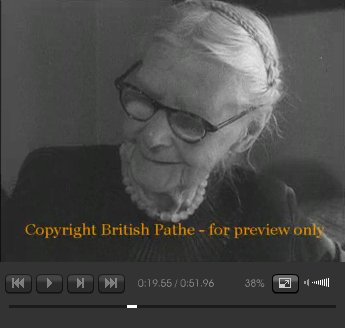Ethel Voynich’s story (1864 – 1960) is quite fascinating: while the young Ethel (‘Lily’) Boole was studying music in Berlin, she became inspired by Stepniak’s revolutionary writings. As a result, she became closely involved with Russian dissidents living in London, and in 1893 married the very charming Wilfrid Voynich. Voynich himself often travelled around as part of the League of Book Carriers, smuggling revolutionary books into Tsarist Russia (because of course Marx, Lenin, etc were all in London at the time), and doubtless Ethel did much the same for the cause.
Music and revolutionary fervour aside, Ethel’s third major passion was writing: somewhat amazingly, her novel “The Gadfly” (“Ovod“) ended up selling 2,500,000 copies in Russia without her really knowing of its success (it was even filmed twice, in 1928 and 1955). Oddly, it had long been believed in Russia that she was dead: so when it was discovered that she was alive and living in New York, some star-struck artists from the Bolshoi (Susanna Zvyagina and Yaraslav Sekh) called by her apartment in 1959 to give her flowers etc.
Splendidly, some British Pathe film footage was taken of this meeting, which has now been placed online: though less than a minute’s worth, here it is in all its silent glory. (Incidentally, if you pause the film about 25 seconds in, I suspect that the woman on the right may well be Anne Nill.) Enjoy!

You are correct the woman to the right is indeed Anne Nill, Ethel’s partner for some 30 years. ELV was also featured in a Look magazine article after she was “discovered” alive and well and living in NYC by a member of the Russian delegation to the UN. She eventually did receive a royalty check for $15,000 from Russia, a considerable sum in the mid-1950s.
Pam: thanks for dropping by & confirming this, much appreciated! Incidentally, I often direct people towards your excellent article on Ethel Voynich, a very nicely balanced piece. 🙂
My layperson’s simplistic understanding of post acqusition of said manuscript by Wilfred in 1912, is that he strongly believed that it was likely to have been compiled by Roger Bacon. Had this been so, it would have undoubtedly made a fairly handsome quick return for him in the antiquarian book market of the day. Rather than seriously seeking a buyer, he apparently hung on to his prize until 1922 when he sought the help of Bill Newbold, self styled velum, ink and pigment expert to give him an honest appraisal. When this effort turned out to be inconclusive, he put his book on the shelf, where it collected dust and the odd wire worm until his sad departure in 1930. We’re led to believe that over the ensuing thirty years, Lily (Ethel) Voynich nee Boole, with her very close assistant Anne Nill, apparently made knowledgeable, concerted efforts to make headway with the manuscript, although we’re not to know what was posted on the final conclusions before she passed in 1960. So what we seem to have, is an hiatus period of forty eight years, with no effort made whatsover to commercialise on what might have presented as a pretty unique and valuable piece of merchandise, either by the great man of arguably doubtful repute, nor by his partner, who was said to have been, poor but uncommonly honest in her business dealing. I’m not for a minute suggesting anything but wonderment and I’ll also own that I might well be quite adrift in my simplistic summation. What I am, with a degree of fubl’tance is inviting readers to do is to check the 1912 date and tell me if it gives a hint to the inherant interesting possibilities. NB: fubl with the Gothic ‘s’ appears to mean subtle..FUBL also has a more modern definition, something akin to ‘immersing one’s body or parts into a colour accentuated Bath’, whatever that’s supposed to mean.